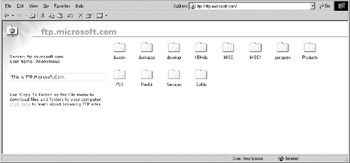Use Special Types of Links
|
Using links for site navigation and to connect with other sites only scratches the surface of what you can do with links. Remember the different protocols mentioned earlier in this chapter? The following describes how some of them are used.
Use mailto: to Create E-mail Links
One of the more challenging aspects of Web authoring is designing systems for your visitors to respond to your site. Many of these require venturing outside the secure world of HTML into more complex programming languages. One easy way to enable people to contact you from your site is by including an e-mail link with the mailto: protocol.
To put an e-mail link in a page you can type something like this:
<a href="mailto:myEmail@server.com">Email Me!</a>
When someone clicks this link, it opens the browser’s e-mail program with an e-mail window already addressed to you. All they have to do is write a note and click Send.
Use ftp:// to Link to Download Sites
FTP stands for File Transfer Protocol. You will become very familiar with the ftp:// protocol when you are ready to publish your Web site to a server because that’s how you get your files from your computer to your host’s. What you might not know is that there are many public FTP sites called anonymous ftp sites. These allow you to log in, usually with the username “anonymous,” and download information. You might want to provide a link to a site that offers information related to your site’s topic. For example the following code listing contains a link that will take your visitors to Microsoft's FTP site. The illustration that follows shows you what your visitors will see if they follow that link.
Find Microsoft downloads at the: <a href="ftp://ftp.microsoft.com"> Microsoft FTP Site</a>.

A visitor who clicks this link will be transferred to Microsoft’s anonymous FTP site, where they will be able to find a wealth of downloads and information. As always, be sure you have the right to link to information on the Internet before you do so. With most public sites such as this, there will be no problem. However, if you’re in doubt, be sure and contact the site administrator before creating the link.
Link to Usenet Newsgroups with news:
The news:// protocol enables you to link your visitors to Usenet newsgroups. Newsgroups are veterans of the Internet’s early days and work something like huge e-mail groups. Groups organized around common interests abound and can be a great source of information. Perhaps you might like to put visitors in touch with a link to an amateur astronomy newsgroup. You could add a link such as this:
<a href="news:sci.astro.amateur"> Amateur Astronomers' Newsgroup</a>
Assuming your visitors have their browsers configured for newsgroups, this link opens up their news reader and enables them to tie into the group. As you read in the “Understand URLs” section, there are other protocols, but these are the ones you are likely to use most often.
| Tip | To find newsgroups to link to, try doing a search on Usenet in any search engine. |
Until now, you have been working with plain text links—nothing fancy and definitely not pretty. Not many years ago, that’s what you would have been limited to when adding links to your page. Fortunately, things have changed. It is now possible for you to have useful links and good-looking ones, too.
| Note | Another way to write the newsgroup protocol is nntp://. |
|
EAN: 2147483647
Pages: 126